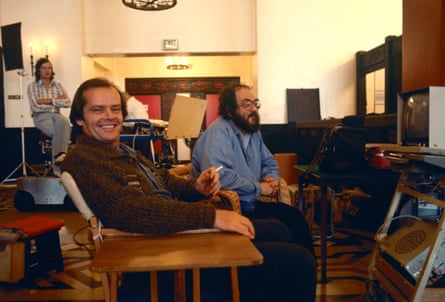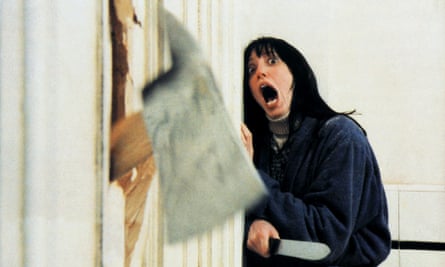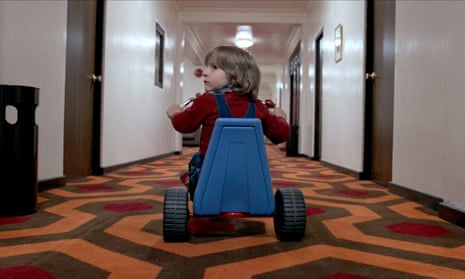Eight years ago, the Rodney Ascher documentary Room 237 reignited discussion over Stanley Kubrick’s The Shining by surveying a range of different fan theories on what the film is about, and the evidence that exists to support those theories. Some of the ideas are legitimately compelling, like one that posits the film as an excoriation of American imperialism, jumping off from the fact that its haunted hotel, The Overlook, was built on a Native American burial ground, and continuing with other references and bric-a-brac to back it up (Can those cans of Calumet Baking Powder be a coincidence?!). Others are mostly cockamamie, like the theory that Kubrick had made the film as an apologia for his role in faking the moon landing. (Why else would Danny be wearing an Apollo 11 sweater?!)
Kubrick’s longtime aide Leon Vitali – who the 2017 doc Filmworker painted as Igor to the director’s Dr Frankenstein – scoffed at the interpretations floated by Room 237, but it was never the point of the documentary to convince the audience to buy into any one take on The Shining. Its deeper purpose was to celebrate The Shining as a glorious enigma, a film that invites Grand Unifying Theories without ever quite affirming any of them. We’re no closer to figuring it out now than we were 40 years ago, but like The Overlook itself, there’s some indefinable allure that keeps beckoning us back for a visit. Like Jack Torrance, the murderous caretaker played by Jack Nicholson, it’s starting to feel like we’ve always been here.
Like a lot of Kubrick’s work, especially the films toward the back half of his career, The Shining was greeted first with bafflement and hostility before people started to come around on it. The hostility has faded as the film has gotten more widely recognized as a horror staple; the author Stephen King still famously dislikes what Kubrick did with his book, but the recent adaptation of King’s sequel, Doctor Sleep, leans heavily into the film’s iconography. But the bafflement is baked into the pie – it’s what makes the film so primally terrifying and unsettling to experience, and what teases the brain into trying to solve it.

The astonishing opening shots of Jack wending his way up the Colorado mountains are a sign of things to come: Wendy Carlos and Rachel Elkind’s eerie Moog interpretation of Hector Berlioz’s Symphonie fantastique, the mirroring of the landscape against a placid lake, and most crucially, the breathless whoosh of the camera. With Steadicam mounts finally available to combine movement with stability, Kubrick experiments as much as any film since in what a constantly roving camera could do to unmoor an audience. Even in the relatively benign early scenes of Jack heading to the interview or the whole Torrance clan, including his wife Wendy (Shelley Duvall) and son Danny (Danny Lloyd), getting a tour of the hotel, it feels like a game of chicken, as if the camera were zooming headlong into danger and we can’t be assured it will ever swerve away.
As the Torrances settle into The Overlook for the winter and a snowstorm severs their connection to the outside world, the madness that quickly seizes Jack – too quickly, many critics at the time griped – starts to ramp up a whole strategy of disorientation. Kubrick makes a joke out of titles announcing different days of the week, as if time has any meaning in isolation, and the geography of The Overlook is impossible to map, despite (or because of) the many shots of Danny rolling through the hallways on his Big Wheel. The kitchen, the living quarters, the Gold Room, the upper floors where the previous caretaker axed his own family, the dreaded Room 237 — all distinct spaces, but there’s no guessing how they all connect.
Kubrick’s sense of humor is one of his less appreciated qualities, even in non-comedies like Barry Lyndon or Eyes Wide Shut, and The Shining relishes the opportunity to goof on the horror genre, whether through the flourishes of Nicholson’s performance (“Heeeeeere’s Johnny!”) or the odyssey of the Overlook’s head chef (Scatman Crouthers), who answers Danny’s psychic SOS, only to get an axe in the chest. However viewers might expect a horror film to behave, Kubrick seems hellbent on defying it, whether that means creating dreamlike cascades of blood around an elevator bank, flashing on scenes of past carnage, or just having a laugh over the expectation that the chef’s long rescue mission will amount to anything.
Every rewatch of The Shining seems to trigger a new obsession, often depending on who’s doing the watching or when. Kubrick’s treatment of Duvall, for example, has gotten renewed scrutiny in light of abuses against women in the film industry, and so witnessing her raw vulnerability as Wendy, the one non-possessed member of the Torrance family, feels like a grim twist on Method performance. Watching The Shining under Covid-19 quarantine, too, makes it seems like an uncanny echo of the anxious state of isolation, where the days are blurry and borderless, and a cavernous hotel can feel as confined as a studio apartment. Even those in their right mind are now a little better acquainted with madness.

Of the theories swirling around The Shining, the one that seems the most plausible 40 years later is The Overlook as a metaphor for the horrors wrought by the American elite, which ties into the cloistered world of Kubrick’s Eyes Wide Shut and his career-long skepticism of the powerful. In touring the place, Jack is told that the Overlook was “one of the stopping places for the jet set,” where all sorts of important people had stayed, including four presidents, and surely made consequential decisions as they were perched on high. Hearing about the hotel being built on a Native American burial ground may add the threat of retribution from beyond the grave, but Kubrick suggests this desecration is the original sin, like an evil embedded in the hotel’s foundation.
“All the best people” stayed at The Overlook, Jack is told, and where have you heard that phrase before? The hotel has a presence – a shining – that’s frightening to those who are sensitive to it, like the chef and Danny, but it’s scariest of all for being both irredeemable and indestructible. Jack having been there before, and Jack attempting more or less the same murder as a previous caretaker, is a sign that history will keep on repeating itself. And for the powerful people who vacation there, these are the rooms where it happens. The sad truth about The Overlook is that what happened to the Torrances will probably get cleaned up for the next season and turn into a cautionary anecdote for the next half-cracked caretaker who wants the job. The carnage never ends.

Comments (…)
Sign in or create your Guardian account to join the discussion